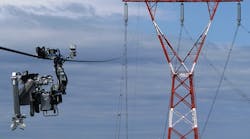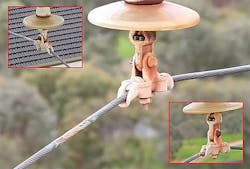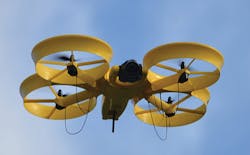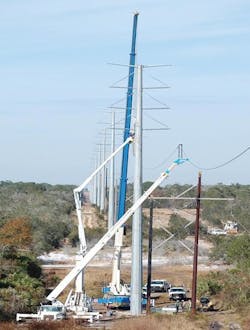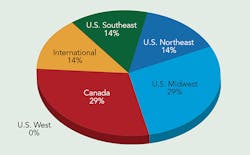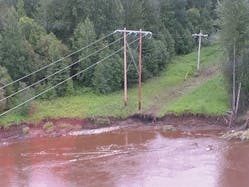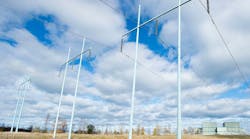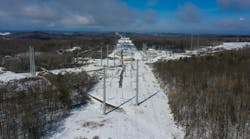The expected increase in live-line work technologies to maintain, repair, reconductor and rebuild lines and equipment has stimulated the development and use of robotic devices. These devices safely minimize risk to field personnel, reduce operational costs and maintain power system reliability.
Utilities and service providers currently employ three primary robotic technologies:
- Ground-based robots are designed to capture and control energized conductors remotely and execute tasks that are far beyond human capability. This mature technology has been used for more than 10 years, with recent improvements capable of handling extreme weight and conductor sizes. While ground-based robots excel at tasks related to the maintenance, upgrade and construction of transmission lines such as structure replacement, conductor replacement and insulation changes, the current limitations of this type of robot include dead-end and lattice structures with a center-phase conductor. Mitigation solutions have been developed to overcome these limitations during construction projects.
-
Line-suspended robots are designed to serve as the extended eyes and arms of a lineman, and their basic design function is to perform visual inspections and small maintenance activity. This technology has been used for five to eight years and is capable of at least a dozen tasks related to visual inspections by different types of cameras, use of specialized sensors, temporary repairs/adjustments of transmission line components and specialized applications. Currently, line-suspended robots are able to travel over a live conductor or overhead ground wire of transmission lines with different line slopes, though usually no more than 30 to 35 degrees.
Some of the more advanced line-suspended robots are able to pass through or cross over different transmission line components such as wind dampers, double-suspension clamps with yoke plates and bundled conductor clamps, spacers for bundled conductor, splices and sleeves, and warning spheres. The limitations of these types of robots include spiral wind vibration dampers, angled or dead-end insulator strings, galloping mitigation devices and conductor bundles in a vertical configuration. - Aerial robots, or unmanned aerial vehicles (UAVs), are designed primarily to perform visual inspections with different types of cameras. Typical items inspected using UAVs include transmission line components, right-of-way (ROW) conditions, vegetation under the ROW, access into the structures, violations to the ROW, landslides near the structure footings and other unusual activities. The main limitations of these robots include risk of collision, rules and regulations from aviation regulatory agencies, and unexpected environmental changes like wind gusts.
Current Trends
Based on a research and development (R&D) initiative sponsored by 30 leading international electrical utilities — members of CEATI International Transmission Line Asset Management group — a comprehensive review of utilities’ and service providers’ use of state-of-the-art robots for live-line transmission work was performed. An initial literature review of public information was completed, followed by the development and implementation of surveys that included robotic applications for energized transmission line work. The survey was followed by information requests and interviews with utilities and robot manufacturers.
Fifty-six utilities were contacted and data requests were sent to qualified service providers located in Canada, China, Japan and the United States. Of the 56 utilities contacted, 25 utilities responded. Thirty-two percent, or eight of the 25 utility respondents, reported using robotics for their energized transmission line work.
Among the utility respondents that use robotic technology, about 63% use ground-based robots, 38% use robots suspended from the line and only about 13% use aerial robots. Several of the utilities use more than one type of robotic technology. According to the utility respondents, the most common application for ground-based robotics is the repair or replacement of a structure (75%), followed by insulator cleaning (25%).
After five years of active R&D work on the topic of robotic applications for energized transmission line work, it is evident how the different technologies are strengthening their position in the marketplace. Overall, the utility respondents using robotic technology for transmission maintenance applications say they have a need for this type of technology. The need is largely dependent on three factors:
- Region and geographic location of the utility
- System topology (large radial feeds)
- System operation constraints (lightly loaded versus heavily loaded lines).
The use of robotic technologies in the electric power industry is expected to increase significantly over the next 10 to 15 years. Electric power utilities, line maintenance companies and renewable energy service providers are investing substantial R&D into robotic technologies. Technology transfer from the construction, automotive and military markets is making the accelerated effort possible. However, it will take years for the power industry to standardize energized line robotic technologies because of the development cycles, safety procedures and government regulations.
Economic Justification
The use of robotic technologies is mainly driven by the economic benefits derived by the continuous use of the electric power installations. An outage of any element of the electric power system is not allowed while applying any of the robotic technologies listed.
To quantify the economic benefits of ground-based energized work, specifically the most common application of replacing transmission line structures, the following applicable metrics were determined:
- Dispatch and production cost
- Open Access Same Time Information System (OASIS) reservation and loss of revenue
- Manpower cost
- Reliability value.
The first three metrics were quantified using public information and assume a transmission line outage duration of 120 days is required to replace the structures using de-energized work techniques and 150 days to replace the structures using energized work techniques. In addition, for the energized work, the metrics assume a seven-person crew to install the foundations, a four-person support crew and an 11-person qualified live-line lineman crew.
Quantifying the metrics shows that restoring a transmission line outage with a duration of 120 days using de-energized work techniques has a direct economic impact on the utility cost and revenue. The majority of the economic impact is related to the redispatch and production cost, which is on the order of US$4.74 million, followed by the OASIS reservation loss of revenue, which is on the order of $1.45 million. However, de-energized work requires less time and equipment, so performing this work using de-energized techniques results in less manpower cost compared with energized techniques. The increased cost of executing the work energized is calculated to be $447,000 with respect to the manpower cost metric.
In summary, performing the work de-energized would have an estimated cost of $6.2 million versus $447,000 in costs performing the work energized. Therefore, the benefits of energized work are on the order of $5.75 million.
Future Opportunities
Ground-based and line-suspended robotics for energized transmission work have been in existence the longest, with improvements made to these technologies and processes over time. The use of robots suspended from the line have advanced in the last two or three years. Recently, electric power utilities are increasingly interested in investigating aerial-based UAV technology for routine inspection automation and asset condition assessment to reduce the potential safety risks to maintenance crews, execute repetitive inspection tasks faster and decrease costs for tasks executed.
Recent advances in UAV technology present potential opportunities for these devices to be used in place of conventional manned helicopters, ground patrols, climbing inspections and traditional aerial inspections. UAVs are being tested by several robot manufacturers and service providers for applications required to manage electric utility transmission line assets. This technology has matured to a point that utilities are now investigating their use. While most of the activities regarding the use of UAV are outside North America, a number of utilities have contacted the aviation industry regulatory body in an effort to test the UAV at the electric power industry.
One of the most significant applications for UAV robotic technology is for storm restoration. In the aftermath of a major extreme weather event, the utility ROW is often obstructed and difficult to access by utility ground crews. UAVs can be deployed quickly and used to assess the degree of asset damage to develop a restoration plan with resource requirements.
Recent research conducted in collaboration with CEATI Transmission Line Asset Management has demonstrated that the quality of information that can be obtained from unmanned aerial vehicles is comparable and, in some cases, exceeds what conventional manned vehicles can obtain.
Worldwide, at least eight UAV models have been tested in different parts of the world for visual inspections of transmission line assets and its nearby environment with promising results. The most advanced UAV models have been subject to intensive laboratory tests in addition to their field trials.
Several utilities, based on their regulatory requirements, inspect transmission line assets by climbing the towers and conducting ground patrols. Research shows the level of detail obtained from UAV-based inspections is comparable or better than human-based inspections. Thus, aerial-based robotics is expected to increase in use in the foreseeable future.
Robotic Technologies
All three robotic technologies — ground-based, line-suspended and UAV — have their pros and cons. At the end of the day, it is all about the economic benefits for the task at hand and the business case they can make. Methodologies have been developed to quantify technical and economic justification for the application of robots for energized transmission line work, and this is indicative of positive market trends.
Assuming regulatory barriers can be overcome, the market share likely will increase most significantly for UAV robots in the near future. Transmission and distribution infrastructure evaluations after major weather events and detailed transmission line tower inspections are among the most promising applications for UAVs in the electric power industry.
Acknowledgements
Some of the materials included in this article are based on work sponsored by the members of CEATI International Transmission Line Asset Management group. The author acknowledges the years of collaboration on the application of robotic technologies in energized transmission line work.
David Elizondo ([email protected]), director of international business at Quanta Technology, is an expert in robotic applications for transmission lines. He has been the principal investigator on projects related to transmission line robotics applications, energized line recoating, energized robotic maintenance and its implications for transmission line design. He holds a Ph.D. in electrical engineering from Virginia Tech and is currently participating in CIGRE Working Group WGB2.52, Application of Robots for Overhead Transmission Lines.
Mentioned in this article:
CEATI | www.ceati.com
Hydro-Québec | www.hydroquebec.com
